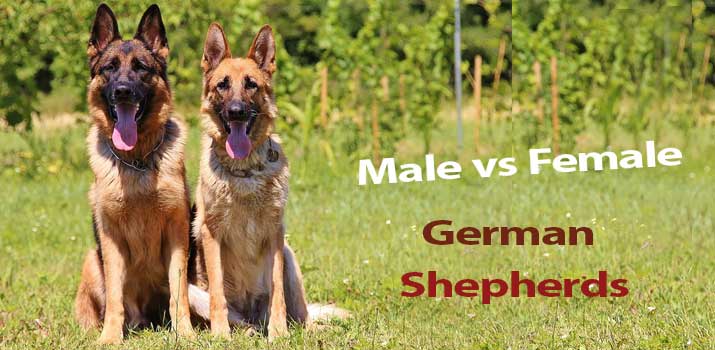
German Shepherds are one of the most revered dog breeds around. First bred in 1899, these dogs have quickly captured the hearts of dog owners across the globe.
You’ll find them acting in movies, assisting police officers, fighting alongside military personnel, and so much more.
Despite all of the roles German Shepherds play, most of them are simply another part of the family. They are great companion dogs that are intelligent, full of energy, and very fun to be around.
If you’re thinking about adopting a German Shepherd pup, there’s one big decision you’re going to have to make.
Do you want a male pup or a female pup?
While most breeds have indistinguishable physical characteristics and personality traits regardless of gender, the same can’t be said about German Shepherds.
Male and females do share a lot in common. However, females have some significant differences set them apart.
These differences can affect your dog’s place in your family, so it’s important to keep them in mind before you go through the adoption process.
4 key female German Shepherd traits that differ from their male counterparts.
1. Phsyical Differences
At first glance, most people won’t be able to tell the difference between a male and a female German Shepherd. Both genders have that striking coat and thick fur.
They also have those iconic perky ears. However, upon closer inspection, you’ll notice some subtle physical variations.
Overall “Feminized” Appearance
German Shepherds are sexually dimorphic.
Basically, this means that they belong to a classification of animals that display different physical characteristics between the two sexes of the same species.
The easiest way to look at sexual dimorphism is it is to think about traditionally masculine and feminine qualities.
The physical differences between males and females are caused by the dog’s hormones as they mature.
Female German Shepherds have a noticeably more graceful look to them.
As a whole, the breed is known for being quite muscular and athletic. This is true for both genders. However, females exhibit a leaner and lighter build.
They’re not as bulky as the males.
This may not be immediately noticeable when you’re looking at a single dog alone. But once you put males and females together, the “feminized” appearance of the ladies is evident.
Size
Female German Shepherds are also a bit smaller in size. Of course, all dogs are different, so outliers do exist. With that said, females are typically about 2 inches shorter than males.
Adult male German Shepherds are between 24 and 26 inches tall at the withers.
Meanwhile, females are usually 22 to 24 inches tall.
Weight
As we mentioned earlier, females are a bit leaner than males.
On average, a fully-grown male German Shepherd tips the scales at around 88 pounds. On the lower end of the spectrum, males can be about 66 pounds.
The weight range for females is between 48 and 70 pounds as an adult. That’s a full 18 pounds lighter on the higher end!
Coat
When it comes to the quality of their coats, there are no established differences between males and females. Both genders have that fluffy mane.
German Shepherds have a double-coat of fur. After all, they were originally bred to herd sheep in harsh weather. Those coats keep them protected from the rain and snow.
These dogs are heavy shedders. Owners must stay on top of regular brushings to keep their pups looking good. As for color, black is often the dominant shade.
Secondary colors of gold, cream, or white can be found throughout the dog’s face and belly.
2. Social Traits
German Shepherds are a highly intelligent dog breed. They can be fiercely loyal to their family, yet distant with strangers.

This applies to all dogs of this breed. Nevertheless, how these dogs behave in social situations is where gender differences really stand out.
It’s important to note that all dogs are a product of their environment. While a lot of their behavioral traits can be linked to their parents, upbringing plays a big role as well.
Early socialization is key when it comes to raising a pup.
Giving your dog plenty of opportunities to socialize with people and pets can have a huge effect on the following traits.
Group Focus
Generally, female German Shepherds are considered to be a better option for larger families. Why is that? Well, it’s because females tend to bond well with other members of the family.
As long as they’re spending an equal amount of time with everyone, you shouldn’t have any issues establishing those important connections and building loyalty.
– Male German Shepherds
The same can’t be said for males. Male German Shepherds will latch onto their primary owner.
They exhibit very obvious signs of loyalty towards the one person who raised them and spends the most time with them. It can appear to be borderline possessive.
– Female German Shepherds
Now, that doesn’t mean that male German Shepherds don’t love other members of the family or won’t protect them. They can develop bonds with everyone they spend any significant amount of time with.
However, they will always show priority to that one person above everyone else.
That important distinction makes females great for social households.
Because they have no problem growing fond of more than one human, you may also find that females respond better to strangers.
Both males and females can be quite aloof when new people come into the mix. But, girls will open up to new faces much quicker.
Guarding Abilities
A dog’s guarding abilities are closely related to who they are loyal to. With a female’s penchant for group socialization, they do pretty when it comes to guarding the entire family.
They’re not going to choose one person over the other, so they can be a great choice when you need a guard dog.
Males, on the other hand, are better at one-on-one protection.
Once they have established that strong bond with one person, they are loyal for life. This is why you see so many male German Shepherds doing police, military, and security work.
They have their owner’s back and will fight to the death to keep them protected.
Sensitive Nature
Females can be very sensitive to the needs of humans. Overall, they’re much gentler and friendlier towards people. Thus, they can make great therapy dogs.
Male German Shepherds can be trained for that job as well. However, they tend to exhibit more pride and stubbornness, which could become an issue.
3. Personality and Temperament
Your dog’s general personality and temperament could affect their behavior and trainability.
All German Shepherds are full of energy and ready to play. But, females tend to be a bit softer than males, which could ultimately make things easier for you in the long run.
Less Teritorrial
The biggest problem that dog owners face with male German Shepherds is their territorial nature. They can become very protective of what they think is theirs.
This could include everything from toys to food dishes. Some males will even urinate everywhere to assert their dominance.
You have to be very vigilant with training if you have a male German Shepherd.
If they don’t have a strong influence, males can grow up to think that they are calling the shots. This could lead to aggressive behavior, so it’s a good idea to invest in training classes as soon as possible.
Females can exhibit some territorial behavior, too. But, it’s usually not that much of an issue.
They’re less likely to guard items and lash out in aggression if they think that someone is crouching on their territory.
Highly Trainable
Thanks to their sensitive nature, females are considered to be easier to train. They can pick up commands quite easily and will love showing you what they can do.
Not only that, but females are often the go-to when it comes to competitive training.
Their smaller bodies make them more agile. Thus, they’re more capable of completing courses.
Males require a bit more work to train. They can be stubborn and difficult to work with. This is especially true if they are on the more aggressive side.
With any German Shepherd, it’s important to use positive reinforcement for training. These dogs are far too smart to respond to negative reinforcement.
Yelling, hitting, or any other form of punishment will only set you back.
Provide plenty of praise and some tasty treats! Both males and females will appreciate the rewards and pick up new skills.
Related: Potty Training a GSD Puppy
See how this female German Shepperd Puppy shows patience and obedience after only 10 weeks of training
4. Health Concerns

As with any dog breed, German Shepherds are at risk of experiencing several health issues. These dogs are quite large, so musculoskeletal problems are common.
Hip dysplasia, in particular, affects roughly 19 percent of all German Shepherds. It can cause debilitating pain, making it difficult for your dog to walk.
Degenerative Myelopathy and elbow dysplasia are prevalent as well. With Degenerative Myelopathy, damage to the spinal cord can make dogs lose control of their hind legs.
Other possible health issues you should be wary about include bloat, and allergies to food ingredients.
Female German Shepherd Risks
There are a couple of conditions that affect females at different rates than males.
The first is Hemophilia A. This is a blood disease that makes it difficult for the dog’s body to develop clots.
There is no cure for the disease, but it can be managed with treatment.
Female German Shepherds are carriers of the disease. But, they don’t show symptoms of the condition like males do. So, diagnosis requires medical testing.
Another notable disease is Idiopathic Epilepsy. The condition causes seizures and could lead to potential brain damage.
While it can affect any German Shepherd, it’s less prevalent in females.
Health Issues Possibly Linked to Spaying
Spaying is recommended for all female dogs that aren’t raised for breeding. It’s meant to control the pet population while also controlling a dog’s hormones and aggression levels.
While the practice is standard for pet owners, some studies have shown that early spaying can increase a female German Shepherd’s chances of experiencing hormone-related illnesses.
It’s considered early spaying when the procedure is performed before the dog reaches 12 months of age.
The studies found that reproductive cancers, such as uterine and mammary cancer, were more common after spaying.
The cause of this has yet to be determined. However, it’s believed that the removal of essential hormones is to blame.
Consult with your vet to decide when the right time to spay your female German Shepherd is.
Conclusion
So, should you get a female German Shepherd or a male one? Ultimately, it all comes down to personal preference. All canines are different and will exhibit unique behavioral traits based on how they grew up.
You can use these differences to get a general idea of what to expect and pick a dog that works for your lifestyle.
Invest in some training classes and give your dog plenty of opportunities to socialize. Before you know it, your German Shepherd will be a loving member of the family.
Also Read: Best Food Brands for German Shepherd Puppies

